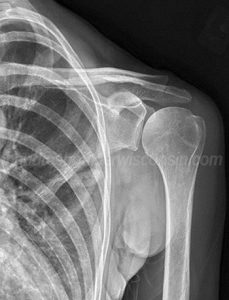The orthopedic doctors at Hand to Shoulder Center are here to diagnose and treat your severe shoulder pain. Contact Hand to Shoulder Center of Wisconsin in Appleton or Green Bay, WI today to learn more about how our orthopedic specialists and therapists can help you.
Reverse Total Shoulder Replacement

Figure 1: Ball and socket joint
Reverse total shoulder replacement surgery (also known as rTSA) is a relatively new implant procedure approved by the FDA in 2004. It is primarily designed for patients with severe shoulder pain including arthritis and deficient rotator cuff muscles. Good candidates for reverse shoulder replacement include shoulders with previous complex fractures and severe arthritis, elderly individuals with significant pain or little to no movement, and patients who have had unsuccessful previous shoulder replacements.
The anatomy of the shoulder is a complex and sophisticated joint. Its complex structure, referred to as a “ball and socket joint,” (Fig. 1) which allows for full range of motion to the arms and hands permit lifting and extending motions to the upper extremities. It’s the most mobile joint in the body, but it is also one of the most potentially unstable joints making it vulnerable to injuries and problems.
The shoulder is made up of three bones and is surrounded by a number of muscles, ligaments, and tendons. The rotator cuff is formed by the tendons of four muscles (supraspinatus, infraspinatus, subscapularis, and teres minor) positioned around the ball and socket joint. The rotator cuff tendons attach to the humeral head providing range of motion and stability to the shoulder. In normal shoulder motions, the tendons glide smoothly with little friction or wear, however, when a rotator cuff tear is present, over time the forces on the ball and socket become imbalanced and lead to cartilage damage and eventually arthritis of the joint. This is referred to as “rotator cuff tear arthropathy.” Traditional shoulder surgery procedures for arthritis in the shoulder do not work well for patients who also have chronic rotator cuff tears. For this reason, reverse total shoulder surgery was developed.
Symptoms
Significant pain is commonly felt in the shoulder and upper arm with daily activities. In certain positions such as reaching or overhead work, shoulder pain can intensify. As time passes, additional symptoms from chronic inflammation and structural damage will lead to loss of range of motion, progressive weakness, and difficulty sleeping as night pain can intensify due to chronic rotator cuff tears and severe arthritis.
Treatment
At Hand to Shoulder Center of Wisconsin, the orthopedic physicians perform a thorough medical evaluation. Health history is discussed in depth along with all prior upper extremity injuries, surgeries, and genetic medical conditions. A physical and visual examination by the physician is completed on the shoulder; arm mobility and active and passive range of motion is measured on the affected shoulder and the opposite shoulder.
X-rays are taken to determine the condition of the shoulder joint. A CT scan and/or Magnetic Resonance Imaging (MRI) may be ordered to evaluate bone quality, the condition of the surrounding tendons, and to further detect additional damage to the shoulder region.
Ideal candidates for reverse total shoulder replacement surgery include:
- A completely torn rotator cuff that is not repairable or failed rotator cuff surgery
- Older individual with severe arthritis in the shoulder joint and little to no mobility in the shoulder joint
- Previously failed surgeries such as shoulder replacement surgery or arthroscopic shoulder surgery with little or no mobility in the shoulder joint

Figure 2: Reverse shoulder ball and socket placement
In reverse shoulder surgery, an artificial implant is used to replace the damaged shoulder in a reverse manner – the socket is placed at the end of the arm while the ball is at the shoulder (Fig. 2). This reverse design offers more stability to the shoulder by utilizing the large shoulder muscle called the deltoid muscle to drive shoulder motion. Incorporating the deltoid muscle compensates for the torn rotator cuff, making it easier to raise the arm overhead. This is not the case with traditional shoulder replacements.
Reverse shoulder replacement surgery is an inpatient surgery that usually requires a two to three day stay in the hospital. Once the surgery is performed, the shoulder will be wrapped with a dressing and a sling which is typically worn for six weeks to restrict movement of shoulder.
During the recovery period, the patient works with a licensed physical or occupational therapist to develop an exercise program focused on regaining range of motion and functional strength in the shoulder and arm. The rehabilitation program will also focus on pain relief and overall arm function designed to fit your physical needs. A well-planned rehabilitation program is vital for a successful reverse shoulder replacement.
In general, patients are encouraged not to overuse the shoulder too quickly as this may jeopardize the strength and stability of the implants creating the new joint. It is critical that the patients do not attempt to reach behind their backs. Recovery time with a properly-designed therapy program will take two to four months. In most cases, patients can return to normal daily activities about four months after surgery. In some cases it may take up to six months to a year.
The expert physicians at Hand to Shoulder Center of Wisconsin are among the most skilled in diagnosis and treatment of shoulder conditions. Reverse shoulder replacement surgery is performed at our three surgery locations in Appleton and Neenah, WI.